Authors: Therabody Scientists: Tim Roberts, MSc; Kyle Silvey, PhD; Michelle Darian, MS, MPH, RD, LDN
Running isn’t just a sport or a form of exercise for people. It’s a lifestyle. It’s a mental break. And just like fitting in a run (no matter the length or pace) is an important part of your routine, building in the time to recover is critical to keep you running. Recovery is essential for continuing to improve running performance — and it can reduce your risk of developing a sports injury that can keep you out of the running game for quite some time.
But recovery doesn’t mean doing nothing. Recovery is an active and dynamic process. There are steps you can take — and technology you can use — to help support and expedite your body’s internal recovery processes. This means that you’re able to hit the pavement, trails, or track sooner, with more energy and with risk of injury.
Here’s what you need to know about recovering from runs, common signs of poor recovery, innovative modalities to address those concerns, and how to use Therabody’s technology to maximize recovery.
What Does Running Recovery Mean?
Running strains the body, mind, muscles, heart, and lungs. During and after a run, your heart rate increases, blood pressure rises, and energy stores deplete. [1, 2]
It also stresses your body. It’s a repetitive movement — you perform the same motions over and over again for miles. Each time you strike the ground, your foot and leg absorb more than your body weight’s worth of pressure. As a result, your muscle fibers experience some tearing and stretching from the movements. [1, 2]
Runners know quite well the feelings of muscle soreness, tension, and stiffness that can accompany a tough workout. Like clockwork, your quads ache, your calves are tight, and you start to question if your soreness is snowballing into pain.
To properly recover from running, you need to get blood circulating. This is why going for a walk or doing a yoga flow can help to shake out sore muscles. Improved blood circulation delivers muscles more oxygen and nutrient-rich blood. In doing so, sensations of stiffness and soreness can start to improve.
So, recovering means that everything mental and physical that shifted during exercise is balanced before your next workout. With the right recovery time and tools, reducing inflammation, stiffness, and soreness is expedited so you can return to the course faster and stronger. [3, 4]

Why is it Important For Runners to Recover?
Here are three benefits runners experience when they prioritize recovery:
- Reduce the risk of common running injuries: Proper recovery doesn’t necessarily mean you won’t sustain an injury like rolling an ankle on uneven pavement — but it can help prevent overuse injuries like shin splints, stress fractures, Achilles tendonitis, plantar fasciitis, and runner’s knee (patellofemoral pain syndrome). One study estimated that up to 70% of runners are subject to a preventable overuse injury each year. [5]
- Prevent overtraining: While feeling sore after a run is common, overtraining syndrome is caused by excessive training without adequate recovery. Overtraining can affect more than just your muscles; it can impact your mental health, mood, hormones, and immune health and can lead to overuse injuries. [6, 7]
- Improve performance: Being relatively free of injuries, soreness, fatigue and being mentally sharp boosts your overall running performance. In fact, a 2022 study of 264 endurance athletes found that the top three finishers used more recovery strategies than those who placed below them. [8]
How Can Technology Help Runners Recover?
There are several common ailments — like muscle soreness, acute pain, joint stiffness, swelling, and delayed onset muscle soreness — that runners experience that may prevent them from running as hard or as often as they want. And research shows that technology effectively targets these specific concerns, expediting recovery.
Based on the latest available science, Therabody products use modalities designed to maximize recovery.
RecoveryTherm: Heat, Cold, and Vibration
Heat, cold, and vibration therapy help to provide therapeutic benefits to stiff, sore, and pained muscles that runners often experience. Here’s how it works:
- Heat therapy: Heat therapy can help to alleviate muscle soreness and stiffness. It increases blood flow — clearing out waste products in the blood that result from strenuous exercise. [9]
- Cold therapy: Cold therapy can help with acute pain (like a rolled ankle) by reducing swelling and inflammation from forming. It can also improve recovery. [10]
- Vibration: Vibration therapy provides a gentle massage that increases circulation and reduces tension, pain, and relaxation. It increases blood flow, making it effective for sensitive areas like joints or sore muscles. Studies show vibration therapy reduces delayed onset muscle soreness (DOMS) when used before or after a tough workout by decreasing pain, stiffness, and swelling. [11]
To experience targeted heat, cold, contrast, and vibration therapy, reach for RecoveryTherm products. Therabody currently offers three RecoveryTherm products:Cube, Knee, and Back and Core. RecoveryTherm Cube offers heat, cold, and contrast therapy that can be applied anywhere that needs extra attention. RecoveryTherm Knee delivers heat, cold, contrast, and vibration therapy to the knee. And finally, RecoveryTherm Back and Core offers heat and vibration therapy.
PRO TIPS: Heat and vibration are great tools to use on stiff and sore areas, while cold therapy is effective for swollen and inflamed areas.
- Before a run: Use heat and vibration therapy for 5-10 minutes to prepare your muscles to hit the road. Still feeling sore from a recent hill workout? Using heat and vibration before your next run can help prep your legs.
- After a run: Use cold and contrast therapy on achy areas post-run. Apply 20 minutes of cold therapy every hour to help reduce inflammation and swelling. RecoveryTherm Cube and Knee devices offer built-in contrast therapy, automatically alternating between cold and heat therapy to maximize recovery.
Theragun: Percussive, Vibration, and Infrared LED Light Therapy
The Theragun delivers percussive therapy to help expedite recovery. Models like the Theragun PRO Plus also offer vibration therapy and infrared LED light to maximize recovery. Here’s how these treatments work:
- Percussive therapy: Percussive therapy stimulates tissues via pressure and vibration and can help with blood flow and oxygen delivery and reduce muscle tension. [12, 13] When used before exercise, it can help reduce DOMS and decrease the sensitivity to DOMS when used post-exercise as well. [14, 15] Percussive therapy can also help with feelings of pain. When we experience pain, the nervous system will try to protect that area, and often, the muscles around it become tight and sore themselves. Treating those muscles can help relieve tension, which in turn can help reduce pain in the adjacent area. [16, 17]
- Vibration therapy: Vibration is less intense than percussive therapy (and may be better suited if the area is sensitive). It can help promote circulation to reduce soreness, stiffness, and pain. [11]
- Infrared LED light therapy: The Theragun PRO Plus delivers infrared LED light directly to the body. Studies show that red and infrared light, in particular, can increase collagen content, improving joint strength. This can help to alleviate joint pain that runners often experience. When applied near the skin, infrared light creates a warming sensation on the skin. It can improve blood circulation, promote injury healing, and help alleviate pain. [18, 19]
To experience targeted percussive therapy, reach for the Theragun. And to combine percussive, vibration, and infrared light therapy, experience the Theragun PRO Plus.
PRO TIPS:
- Warm up: Use the Theragun for 5-10 minutes before a run. Using an attachment of your choice, apply percussive therapy to the bottom of your feet, calves, hamstrings, glutes, quadriceps, IT band, and hips for 30 seconds each.
- Recover: Use the Theragun to help reduce DOMS. Spend more time on each muscle group post-run. Apply percussive therapy for up to two minutes per muscle on the glutes, arches of feet, IT bands, quads, hamstrings, calves, shins, and hips, or any muscle groups that are particularly problematic for you.

RecoveryAir: Pneumatic Compression
Pneumatic compression boots, like RecoveryAir, are an effective way to improve many common ailments runners face — they can alleviate sore and stiff muscles and even temporarily decrease the swelling from running. While pneumatic compression is best known to influence muscle recovery — it can also improve cardiovascular recovery (such as blood pressure, cardiac output, and vascular resistance) to a pre-exercised state. [20, 21]
So, if you’re looking to kickstart your muscle and cardiovascular recovery, pneumatic compression can help. To experience targeted pneumatic compression, reach for RecoveryAir.
PRO TIP: Use the compression boots for 20-40 minutes the night before a long run for fresh legs the next day. After a hard run, throw on the boots for 40-60 minutes to kick off the recovery process.
TheraCup: Cupping Therapy
Cupping therapy uses suction to provide relief to specific spots on the body. This therapy is popular among runners since it can be done at home for instant recovery.
Research shows cupping offers several benefits of interest to runners. It can relax muscles, reduce perceived pain (even more so than over-the-counter medications), and trigger the release of natural pain-relieving compounds in the brain. Cupping gives runners a way to find instant relief after tough workouts or races. [22, 23]
The TheraCup makes it easy for runners to experience the benefits of cupping therapy anytime. It combines suction, heat, and vibration to target sore spots and accelerate recovery. TheraCup is the ideal tool for runners to enhance relaxation, relieve tightness, and get back to running their best.
PRO TIP: Use TheraCup on areas that are particularly stiff and sore, like calves, quads, and hamstrings. Apply the TheraCup in the middle of the muscle and gently glide it for 2-5 minutes, moving carefully around the joints to help reduce muscle stiffness and soreness.
Key Takeaways
- Recovery is an ongoing, active process. Prioritizing recovery tactics before and after a run can help keep your body and mind strong and fast and reduce stress, inflammation, and soreness from your runs.
- Insufficient recovery can impair running performance and increase your risk of overtraining.
- Technology can and should be utilized to help speed recovery.
- Tools that deliver heat, cold, and contrast therapy, percussive therapy, cupping, pneumatic compression, and vibration can help improve blood circulation, reducing common symptoms runners experience that impact their recovery time.
References:
- https://journals.lww.com/acsm-csmr/fulltext/2022/04000/
- https://www.ncbi.nlm.nih.gov/books/NBK482280/
- https://pubmed.ncbi.nlm.nih.gov/27139812/
- https://pubmed.ncbi.nlm.nih.gov/29742750/
- https://www.ncbi.nlm.nih.gov/pmc/articles/PMC3445255/
- https://www.ncbi.nlm.nih.gov/pmc/articles/PMC3435910/
- https://pubmed.ncbi.nlm.nih.gov/1623894/
- https://pubmed.ncbi.nlm.nih.gov/35225908/
- https://pubmed.ncbi.nlm.nih.gov/20448028/
- https://pubmed.ncbi.nlm.nih.gov/28872368/
- https://pubmed.ncbi.nlm.nih.gov/16230984/
- https://www.ncbi.nlm.nih.gov/pmc/articles/PMC3737901/
- https://www.ncbi.nlm.nih.gov/pmc/articles/PMC1128572/
- https://osf.io/preprints/sportrxiv/j9ya8/
- https://www.ncbi.nlm.nih.gov/pmc/articles/PMC6384495/
- https://pubmed.ncbi.nlm.nih.gov/33466606/
- https://pubmed.ncbi.nlm.nih.gov/36161205/
- https://www.ncbi.nlm.nih.gov/pmc/articles/PMC8946909/
- https://pubmed.ncbi.nlm.nih.gov/1727843/
- https://www.ncbi.nlm.nih.gov/pmc/articles/PMC150384/
- https://pubmed.ncbi.nlm.nih.gov/37792163/
- https://pubmed.ncbi.nlm.nih.gov/26891653/
- https://www.cochranelibrary.com/central/doi/10.1002/central/CN-00613456/full







